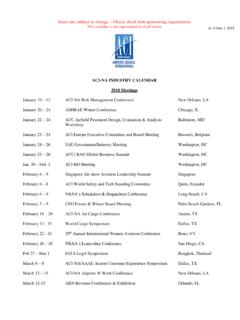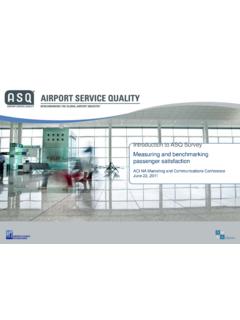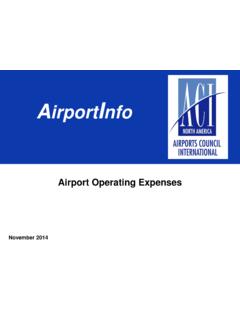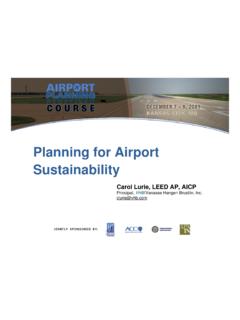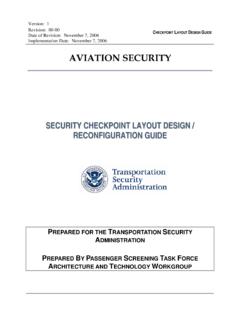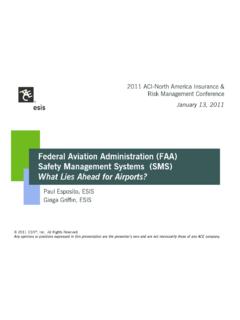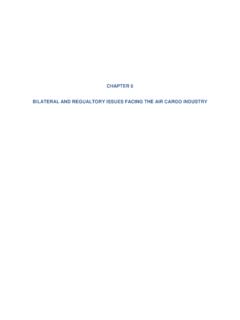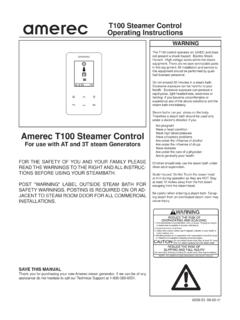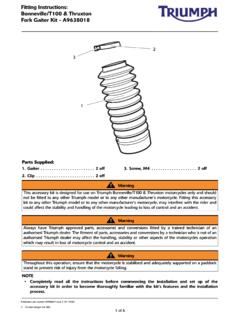Transcription of T-100 Traffic Reporting Guide - North America
1 U. S. DEPARTMENT OF TRANSPORTATION. Research and Innovative Technology Administration Bureau of Transportation Statistics . Office of Airline Information T-100 Traffic Reporting Guide US DOT/RITA/BTS/OFFICE OF AIRLINE INFORMATION. T-100 Traffic Reporting Guide Department of Transportation Research and Innovative Technology Administration Bureau of Transportation Statistics, K-14. Office of Airline Information 400 Seventh Street, SW. Washington, DC 20590-0001. (202) 366-9059. Fax: (202) 366-3383. April 2007. Table of Contents On-Flight Market CALCULATIONS ..21. SYSTEM MARKET-SEGMENT COMPARISONS 4. REVENUE AIRCRAFT HOURS. (AIRBORNE)..23. SERVICE CLASSES AND ENTITY REVENUE AIRCRAFT HOURS (RAMP TO. RAMP)..23. REVENUE AIRCRAFT DEPARTURES. FILING REQUIREMENTS FOR SCHEDULED. PERFORMED ..23. SERVICE .. 8. REVENUE AIRCRAFT MILES FLOWN24. Entity Reporting for Scheduled Service .. 8. REVENUE PASSENGER MILES (RPM'S)24. Reporting Service Class Codes for Scheduled Service AVAILABLE SEAT MILES (ASM'S).
2 25.. 9. REVENUE TON MILES (RTM'S) ..26. FILING REQUIREMENTS FOR NONSCHEDULED AVAILABLE TON MILES (ATM'S)..27. SERVICE .. 10. Entity Reporting for Nonscheduled Service .. 10 BUSINESS RULES ..27. Reporting Service Class Codes for Nonscheduled Service .. 11 BUSINESS RULES SEGMENT DATA ..28. BUSINESS RULES MARKET DATA ..32. FILING REQUIREMENTS FOR .. NONSCHEDULED SERVICE, MILITARY .. 12. Entity Reporting for Nonscheduled Service, Military TERMS AND DEFINITIONS ..34.. 12. Reporting Service Class Codes for Nonscheduled DATA ENTRY SOFTWARE ..40. Service, 13. Reporting T100 SEGMENT DATA ..42. Naming Convention & File DATA ELEMENTS .. 13 Record Layout & Field Descriptions ..43. NON-STOP SEGMENT DATA ELEMENTS .. 14. ON-FLIGHT MARKET DATA ELEMENTS .. 16 Reporting T100 MARKET DATA ..44. Naming Convention & File Record Layout & Field Descriptions ..45. DATA VALIDATION .. 17. THE AIRLINE Reporting & DATA. INFORMATION SYSTEM .. 17. T100 Traffic Reporting SYSTEM. 18. ERROR MESSAGES FOR NON-STOP SEGMENT.
3 DATA .. 19. Sample Validation Report for Non-Stop Segment 20. ERROR MESSAGES FOR ON-FLIGHT MARKET. DATA .. 21. Sample Validation Report for 1. Chapter T100 Traffic Reporting . Overview T he T-100 Air Carrier Traffic and Capacity Data by Non-Stop Segment and On-Flight Market actually contains 5 reports. Two are provided by the U. S. Air Carriers Non-Stop Segment data and On-Flight Market data. As of October 2002, T-1, T-2 and T-3 reports are calculated using the carrier's segment and market data. Non-stop Segment and On-flight Market reports are not interchangeable. Non-stop Segment data are every revenue departure between two points and what is carried between two points on that aircraft, for each departure including passengers, freight, and mail. This includes diversions, flag stops, tech-stops, emergency landings, etc. Segment data are not flight number driven and are referred to as transported data . Note: If an intra-Alaska carrier provides all-cargo service and sells a seat on an all-cargo configured aircraft, the service code F or L is used to identify that a passenger was on the aircraft.
4 The carrier still reports the aircraft type as a 2 to signify the all-cargo aircraft. On-flight Market data are passengers, freight, and mail enplaned between those two points regardless of the number of stops between the points. Market data are flight number driven. So, if your flight number changes, your market will terminate and a new market will begin. Market data are referred to as enplanement data . For one stop flights, the number of passengers reported would be the same for segment and market data. Every passenger on a flight leaving an airport is a segment passenger, but some of these passengers may not be market passengers of that airport if they boarded the flight at the up line airport. System Market-Segment Comparisons System Market data can NOT be greater than System Segment data The system market data MUST be less than or equal to your system segment data. This comparison is true for origin airports. We DO NOT use origin and destination pairs to make this determination because for every segment origin and destination record, there may not be a corresponding market record with the same origin and destination, or there may be a corresponding market record with the same origin and destination but the information is greater than the segment data record.
5 If for any reason the market data are greater than the segment data for their entire system or at the origin airport the carrier will be contacted to correct the appropriate records. Examples: Flight # 1 JFK-ORD-LAX. Flight #2 JFK-LAX. Flight #1 Segments = JFK-ORD (10 JFK-ORD, 5 JFK-LAX), and ORD-LAX, (6 ORD-LAX). Flight #1 Markets = JFK-ORD = 10, ORD-LAX = 6, JFK-LAX = 5. Flight #2 Segment = JFK-LAX (50 to LAX). Flight #2 Market = JFK-LAX = 50. 4. The results of adding the totals by airport pairs are: Segments: Markets: JFK-ORD= 15 JFK-ORD = 10. ORD-LAX = 11 JFK-LAX = 55. JFK-LAX = 50 ORD-LAX = 6. As you can see in the example above, the market pair data for JFK . LAX are greater than the segment pair data. This is the reason why we use only the ORIGIN AIRPORT when validating the data. By using the origin airports only, we have a meaningful validation of the data. Example: JFK segment = 65. JFK market = 65. ORD segment = 11. ORD market = 6. By adding the ORIGIN AIRPORT for all like instances in both the segment and market data, we can verify that the data are reasonable.
6 If the totals for the market ORIGIN AIRPORTS are greater than the segment ORIGIN AIRPORTS, the carrier is contacted and asked to correct the appropriate records and/or fields. ** Please Note **. For information on DoT Data Entry Software available for Reporting T100 data and File & Record Descriptions, Please refer to Chapter 8. 5. 2. Chapter T100 Traffic Reporting . Service Classes and Entity Reporting Beginning with October 2002 T100 Traffic Data . The Office of Airline Information collects Market and Segment data from Reporting Carriers by the following Service Class codes: from & Foreign Carriers: F, G, L, P. from Carriers: N, R. from Foreign Carriers: Q. The regulations define the service classes to be reported as: F - Schedule Passenger Service (includes Freight/Mail in the Belly). G - Scheduled ALL Cargo Service (NO Passengers). L - Non-Scheduled Passenger Service (includes Freight/Mail in the Belly). N - Non-Scheduled Military Passenger Service by Carriers (includes Freight/Mail in the Belly).
7 P - Non-Scheduled ALL Cargo Service (NO Passengers). R - Non-Scheduled Military ALL Cargo Service by Carriers (NO Passengers). Q - Non-Scheduled Services by Foreign Carriers (Other than Charter). 6. The following Carrier data products are created: T1 - US Air Carriers Traffic Schedule Data T2 - US Air Carriers Traffic & Capacity Data, summarized by Aircraft Type T3 - US Air Carriers Airport Activity Statistics Data OAI includes and/or calculates the following Service Classes in the T1, T2, and T3 products: Z - ALL Carrier Services (K+V). (calculated for the T1 & T2). K - Scheduled Carrier Service (F+G). (calculated for the T1, T2 & T3). F - Schedule Passenger Service . includes Freight/Mail in the Belly (T1 & T2). G - Scheduled ALL Cargo Service . NO Passengers (T1 & T2). V - Non-Scheduled Carrier Service (L+N+P+R). (calculated for the T1, T2 & T3). L - Non-Scheduled Passenger Service . includes Freight/Mail in the Belly (T1). N - Non-Scheduled Military Passenger Service . includes Freight/Mail in the Belly (T1).
8 P - Non-Scheduled ALL Cargo Service . NO Passengers (T1). R - Non-Scheduled Military ALL Cargo Service . NO Passengers (T1). 7. Filing Requirements for Scheduled Service Scheduled Service is defined as . Transport Service operated pursuant to a Published Flight Schedule - advertised and available to the general public. Entity Reporting for Scheduled Service Each Carrier is assigned a unique 5 character Entity Code. This code is assigned by the Department of Transportation's Office of Airline Information to denote a carrier's operating entity. For Scheduled Service, the following Reporting operating entities are assigned: DOMESTIC. ATLANTIC. LATIN. PACIFIC. Carriers that operate scheduled service to and from Canada are to report this service under their Domestic Entity Code. US US FOREIGN. POINT A-----------POINT B------------POINT C. Point A to Point B segment report as domestic Point B to Point C segment report as international Point A to Point B market report as domestic Point A to Point C market report as international Point B to Point C market report as international 8.
9 Reporting Service Class Codes for Scheduled Service Domestic: F = Scheduled Passenger/Cargo Service Can include Freight/Mail in the belly G = Scheduled ALL- Cargo Service Freight/Mail ONLY NO Passengers International - ATLANTIC, LATIN, PACIFIC: F = Scheduled Passenger/Cargo Service Can include Freight/Mail in the belly G = Scheduled ALL- Cargo Service Freight/Mail ONLY NO Passengers From this reported scheduled data, OAI calculates . Total Scheduled service: K = F + G . OAI also calculates . Total Nonscheduled service: V = L + N + P + R . and . Total of all services: Z = K + V . The above calculated service classes can be found on the BTS website at 9. Filing Requirements for Nonscheduled Service Nonscheduled Service is defined as . Revenue Flights, such as Charter that are NOT operated in regular scheduled service. Charter service and Nonscheduled service are the same. Entity Reporting for Nonscheduled Service Each Carrier is assigned a unique 5 character Entity Code. This code is assigned by the Department of Transportation's Office of Airline Information to denote a carrier's operating entity.
10 For Nonscheduled Service, the following Reporting operating entities are assigned: DOMESTIC. INTERNATIONAL. Charter/Nonscheduled carriers that operate to and from Canada are to report this service under their International Entity. US US FOREIGN. POINT A-----------POINT B------------POINT C. Point A to Point B segment report as domestic Point B to Point C segment report as international Point A to Point B market report as domestic Point A to Point C market report as international Point B to Point C market report as international NOTE: If no passengers are deplaned at B , the entire flight may be reported as international, especially if no one enplanes or deplanes at B ; or, if passengers are enplaned at A and B and deplaned at C . If the Carrier ONLY has a Domestic Entity, report under the Domestic Entity. 10. Reporting Service Class Codes for Nonscheduled Service Domestic: L = Nonscheduled Passenger/Cargo Service Can include Freight/Mail in the belly P = Nonscheduled ALL Cargo Service Freight/Mail ONLY NO Passengers International: L = Nonscheduled Passenger/Cargo Service Can include Freight/Mail in the belly P = Nonscheduled ALL Cargo Service Freight/Mail ONLY NO Passengers From this reported nonscheduled nonmilitary data, along with nonscheduled Military service, OAI calculates.
